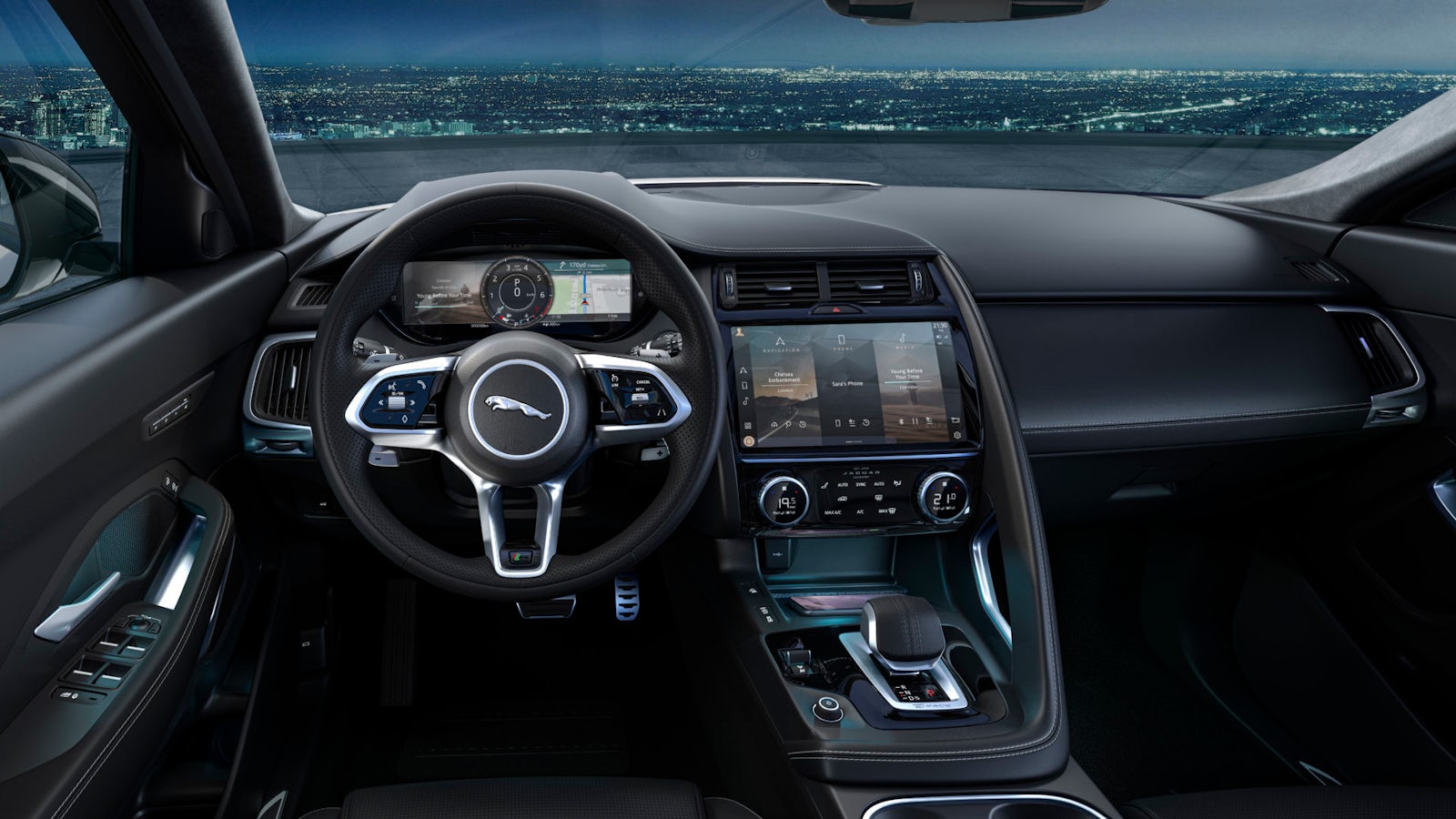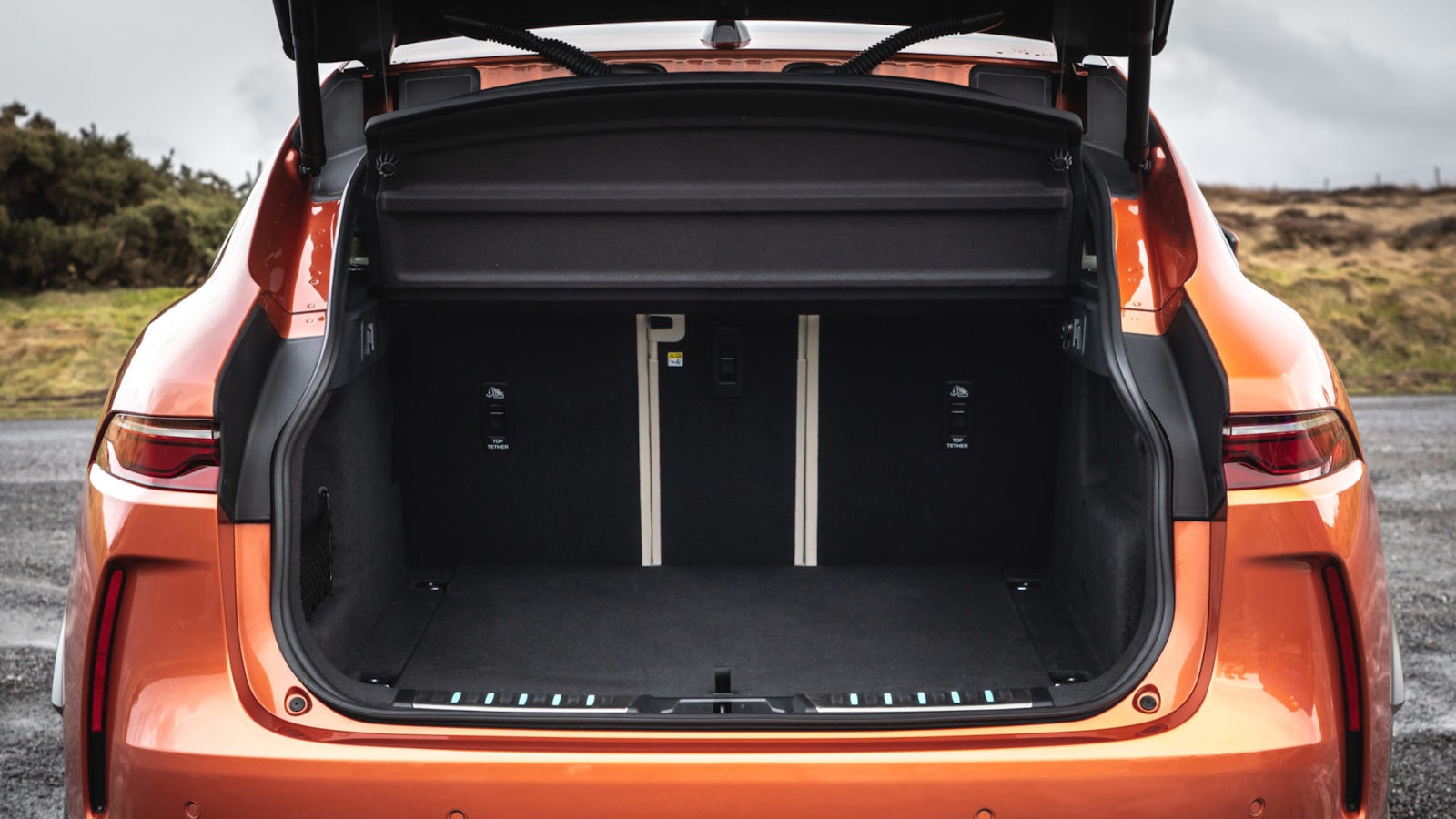Jaguar E-Pace vs F-Pace
July 27, 2022 by Jamie Edkins

At a glance, the Jaguar E-Pace and Jaguar F-Pace look pretty similar, however there are some key differences between these two SUVs.
If you’re stuck trying to decide which is best for you, this handy guide will walk you through what to expect from each model, and how they differ.
Styling

At a glance, you might dismiss the E-Pace as a smaller F-Pace but, if you look closer, more obvious differences start to emerge. Most noticeably, the E-Pace’s headlights are much larger and sweep up the bonnet. The F-Pace on the other hand is sporting much more narrow units, closely mimicking those found on the Jaguar F-Type sports car.

Jaguar’s rounded rectangular grille is now wider on the E-Pace and it retains the power bulge on the bonnet. Both have similar blade-like brakelights, although the F-Pace’s have more strongly stylised LED elements in them.

Down the sides, the E-Pace benefits from more exaggerated styling lines running beneath the windows than the F-Pace. The flowing line from the headlights continues all the way down the car and goes over the rear wheel – another nod to the F-Type – while the F-Pace makes do with more subdued sculpted flanks.

The F-Pace’s roofline is much longer, too, to accommodate a larger cabin, where the E-Pace’s roof is much more curved. The E-Pace also gets a lower styling line running along the bottom edge of the doors to break up the bodywork.
Interior
The cabins are more distinct than the bodies. The E-Pace’s cockpit is heavily influenced by the F-Type with a wraparound dashboard starting from the passenger grab handle on the centre console running over the dials and meeting the driver’s door.

An 11.4-inch touchscreen infotainment system comes as standard in the E-Pace in the centre console. Below the screen sit some physical climate controls, and you also get the option of a configurable 12.3-inch screen in place of the traditional gauge cluster.

The F-Pace’s interior is more similar to those seen on the XE and XF saloons. Its centre console is more separate from the driver’s cockpit than the E-Pace’s and features the slightly more modern Pivi Pro infotainment system. Overall, the F-Pace has the more luxurious feeling interior as well, although this isn’t surprising seeing as it’s the more expensive car here.

Practicality and boot space
Being the larger car of the two, the Jaguar F-Pace offers the most interior space. Rear passengers will have more head and legroom, while those in the front will have plenty of adjustment to get comfortable. The boot is also slightly larger than the E-Pace as well at 613-litres.

By comparison, the Jaguar E-Pace has a 601-litre boot. It’s by no means impractical, with enough space in the rear for average-sized adults and a great driving position. It’s just slightly hindered by its smaller form factor.

Driving
Jaguar is known for building sporty cars so has worked hard to make sure the E-Pace lives up to this reputation. Many body components and parts of the suspension are made from aluminium, which is lighter than steel and allows the structure to be more stiff.
Models equipped with four-wheel drive have computers to shift the engine’s power forward and backwards to make the most of available grip, while top-end versions can distribute power between the rear wheels to make the car feel keener to turn into corners. That said, it still feels like a heavy car and won’t put a smile on your face like the BMW X2 will.
The F-Pace is larger and heavier than the E-Pace but still offers a suitably sporty driving experience. It’s based on a larger platform borrowed from the XE and XF however it comes with all-wheel-drive as standard, compared to the E-Pace’s native front-wheel drive layout.
This means basic F-Paces will have more planted handling style while E-Paces will feel smaller and more hatchback like. Both cars can be fitted with All-Terrain Surface Control that functions as a low-speed cruise control when driving off road or in slippery conditions.
Engines
The smaller E-Pace comes as standard with a 2.0-litre diesel engine with 163hp. This is the only engine you can have with a six-speed manual gearbox and front wheel dive, and it’ll be the most economical as well. For a bit of extra cash, you can upgrade this to an all-wheel-drive version with mild hybrid technology and an eight-speed automatic. Stepping up further, you have the same 2.0-litre diesel engine with 204hp. This is only available with all-wheel-drive and an automatic gearbox.

If it’s a petrol engine you’re after, you have a range of 2.0-litre petrol units to choose from with varying power outputs. The base model gets 200hp, then 249hp and finally 300hp in the range-topping car. Last up is the plug-in hybrid, which pairs a 1.5-litre three-cylinder petrol engine with an electric motor.

All Jaguar F-Pace models come with all-wheel-drive and an eight-speed automatic gearbox. You can have one of four diesel engines, two 2.0-litre four-cylinder units with 163hp or 204hp and two 3.0-litre straight sixes, one of which is a mild hybrid, both with 300hp. Then there are three petrol options, the first being a 2.0-litre four-cylinder with 250hp. Then you have two three-litre straight-six units with either 340hp or 400hp. Finally, there’s a 404hp plug-in hybrid model which pairs a 2.0-litre petrol engine with an electric motor.
MPG, emissions and tax
Both of these cars are available with a range of petrol, diesel and plug-in hybrid engines. If it’s all-out fuel economy you’re after, the plug-in hybrid will be the best bet in both cars. The F-Pace gets a 2.0-litre petrol engine, paired with an electric motor and will return a claimed 130mpg. The E-Pace PHEV gets a 1.5-litre three-cylinder petrol engine and should return a claimed 191mpg. Keep in mind though that PHEVs will often struggle to reach their claimed economy figures under normal driving conditions.
The plug-in hybrid engines will offer the best tax rates for company car buyers thanks to their low emissions, and you can enjoy fully electric motoring around town and on shorter trips.the E-Pace should do 34 miles on electric power alone, while the F-Pace has a claimed 33 miles of range.
Diesel models of the E-pace should return decent fuel economy at around 45mpg, however petrol models are significantly thirstier. The F-Pace is offered with the same diesel options as the E-Pace, however it also has the option of two, more powerful 3.0-litre straight units. These won’t be quite as economical, however they will be much faster. Like with the E-Pace, the petrol engines aren’t that economical, especially the 3.0-litre ones which will struggle to return 30mpg.
Safety and reliability
Both the Jaguar E-Pace and Jaguar F-Pace scored the maximum five stars in their latest Euro NCAP crash tests, so both will offer a decent level of protection should the worst happen.

There are no horror stories to report with either of these cars in terms of reliability, and all Jaguar models come with a three year warranty from new. If this isn’t enough peace of mind for you, then there’s the option to extend your warranty for an additional 12 months.
Price
Considering you’re comparing two cars from separate classes, it’s unsurprising that there’s a noticeable price difference between the two. The entry-level E-Pace costs from £38,220* and comes with a 163hp diesel engine, a six-speed manual gearbox and front-wheel drive only. The entry-level F-Pace costs from £46,250* with the same 163hp diesel engine as the E-Pace, an eight-speed automatic gearbox and all-wheel drive.
Comparable mid-range and top-spec models will have a rough price difference of between £5,000 and £7,000. That extra cash would buy a lot of upgrades for the E-Pace including more powerful engines, four-wheel drive and sportier styling packs – it’s worth considering whether you’d prefer the extra tech and equipment or a larger but less well equipped F-Pace.
E-Pace vs F-Pace Verdict
The Jaguar SUV you ultimately go for will probably have as much to do with your budget as it does with your tastes. If your budget doesn’t stretch much beyond £40,000, the E-Pace is a great choice with a relaxing driving experience, handsome good looks and decent practicality. You could even consider spending closer to an F-Pace’s price and get a highly specced E-Pace with a powerful engine and lots of goodies.
Of course, if you regularly carry rear passengers, they’ll always appreciate the extra space afforded them in the back of the F-Pace. Plus, the extra space in the boot will come in handy if you often carry bulky items, and the F-Pace is a more engaging car to drive. Your budget will determine which model makes the most sense but neither feels like a significantly poorer choice.
Car Change? Carwow!
Looking for a new set of wheels? With Carwow you can sell your car quickly and for a fair price – as well as find great offers on your next one. Whether you’re looking to buy a car brand new, are after something used or you want to explore car leasing options, Carwow is your one stop shop for new car deals.
*Prices correct at the time of writing















